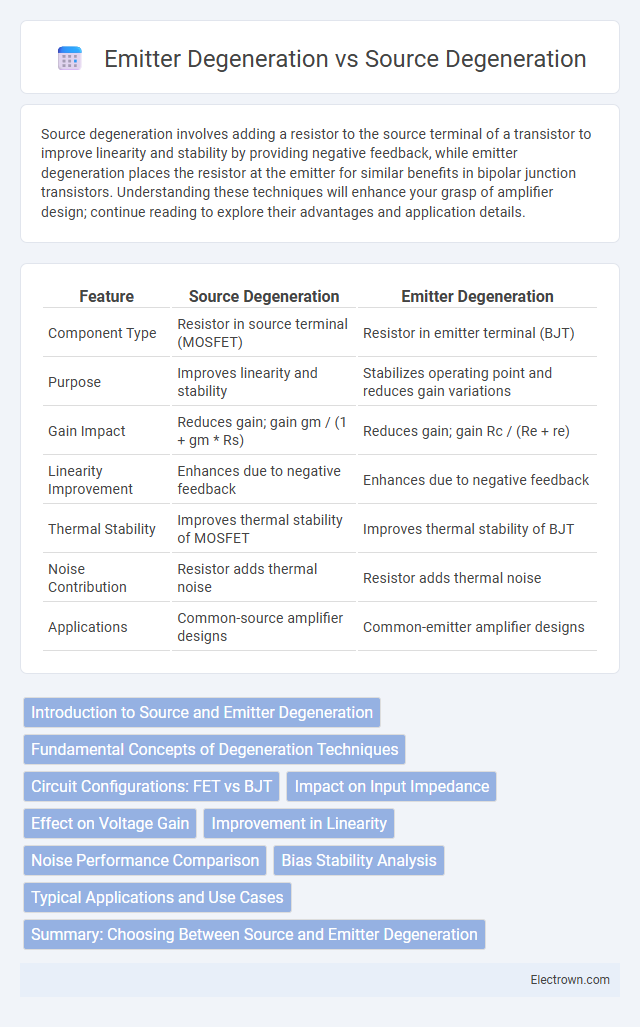Source degeneration involves adding a resistor to the source terminal of a transistor to improve linearity and stability by providing negative feedback, while emitter degeneration places the resistor at the emitter for similar benefits in bipolar junction transistors. Understanding these techniques will enhance your grasp of amplifier design; continue reading to explore their advantages and application details.
Table of Comparison
| Feature | Source Degeneration | Emitter Degeneration |
|---|---|---|
| Component Type | Resistor in source terminal (MOSFET) | Resistor in emitter terminal (BJT) |
| Purpose | Improves linearity and stability | Stabilizes operating point and reduces gain variations |
| Gain Impact | Reduces gain; gain gm / (1 + gm * Rs) | Reduces gain; gain Rc / (Re + re) |
| Linearity Improvement | Enhances due to negative feedback | Enhances due to negative feedback |
| Thermal Stability | Improves thermal stability of MOSFET | Improves thermal stability of BJT |
| Noise Contribution | Resistor adds thermal noise | Resistor adds thermal noise |
| Applications | Common-source amplifier designs | Common-emitter amplifier designs |
Introduction to Source and Emitter Degeneration
Source degeneration and emitter degeneration are techniques used in transistor amplifiers to improve stability and linearity by introducing local negative feedback. Source degeneration applies to MOSFETs by adding a resistor in the source terminal, while emitter degeneration involves inserting a resistor in the emitter terminal of BJTs. Your choice between these methods depends on the type of transistor and specific circuit requirements, impacting gain control and distortion reduction.
Fundamental Concepts of Degeneration Techniques
Source degeneration involves placing a resistor in the source terminal of a MOSFET to improve linearity and stability by providing negative feedback, thus reducing gain sensitivity to transistor parameter variations. Emitter degeneration applies a resistor in the emitter terminal of a bipolar junction transistor (BJT), enhancing linearity, increasing input impedance, and stabilizing current by introducing negative feedback. Both techniques serve to stabilize gain and improve linearity but differ in their application to MOSFETs and BJTs, leveraging negative feedback through source or emitter resistors respectively.
Circuit Configurations: FET vs BJT
Source degeneration in FET circuits involves placing a resistor in the source lead, enhancing linearity and controlling gain by introducing local negative feedback, which stabilizes the operating point. Emitter degeneration in BJT circuits uses a resistor in the emitter path to achieve similar benefits, improving thermal stability and reducing distortion by linearizing the transistor's input-output relationship. Both configurations effectively manage gain and stability, but source degeneration suits FETs' voltage-controlled nature, while emitter degeneration aligns with BJTs' current-controlled characteristics.
Impact on Input Impedance
Source degeneration significantly increases the input impedance of a transistor amplifier by adding a resistor in series with the source terminal, which reduces the gain but improves linearity and stability. In contrast, emitter degeneration in bipolar junction transistors (BJTs) also raises input impedance through a resistor connected to the emitter, controlling gain and minimizing distortion while enhancing thermal stability. Both techniques leverage feedback to enhance input impedance, but source degeneration often yields higher impedance values due to transistor operation differences in FETs versus BJTs.
Effect on Voltage Gain
Source degeneration and emitter degeneration both reduce voltage gain by introducing negative feedback, stabilizing the transistor's operating point. Source degeneration in MOSFETs adds a resistor in the source lead, decreasing gain but improving linearity and gain stability against device variations. Emitter degeneration in BJTs incorporates a resistor in the emitter lead, significantly lowering voltage gain while enhancing thermal stability and reducing distortion in Your amplifier circuit.
Improvement in Linearity
Source degeneration offers improved linearity by increasing the input impedance and stabilizing the transistor's operating point, which reduces distortion at higher frequencies. Emitter degeneration enhances linearity more effectively by introducing negative feedback through the emitter resistor, significantly minimizing gain variations and harmonic distortion in analog circuits. Both techniques improve overall amplifier performance, but emitter degeneration provides superior control over nonlinearities in voltage gain stages.
Noise Performance Comparison
In circuits, source degeneration typically provides better noise performance compared to emitter degeneration because MOSFETs inherently generate less flicker noise than BJTs. Emitter degeneration introduces thermal noise from the emitter resistor, which can degrade the overall noise figure, especially in low-frequency applications. Your choice between the two should consider the specific noise requirements and the device technology used in the design to optimize signal integrity.
Bias Stability Analysis
Emitter degeneration provides superior bias stability by introducing negative feedback through the emitter resistor, which reduces variations caused by transistor beta fluctuations and temperature changes. Source degeneration similarly improves bias stability in MOSFET circuits by adding a source resistor that stabilizes the operating point against threshold voltage shifts and device parameter variations. Both techniques enhance operating point robustness but emitter degeneration is more commonly applied in bipolar junction transistor (BJT) bias stability analysis, while source degeneration is primarily used in MOSFET biasing scenarios.
Typical Applications and Use Cases
Source degeneration is commonly used in MOSFET amplifiers to improve linearity and stability, making it ideal for RF and high-frequency analog circuits where gain accuracy is crucial. Emitter degeneration is frequently applied in bipolar junction transistor (BJT) circuits to enhance input impedance and thermal stability, benefiting audio amplifiers and analog signal processing applications. Both techniques serve to reduce distortion and increase fidelity, with source degeneration preferred in integrated circuits and emitter degeneration favored in discrete transistor designs.
Summary: Choosing Between Source and Emitter Degeneration
Source degeneration increases input impedance and improves thermal stability in MOSFET amplifiers, making it ideal for high-frequency applications. Emitter degeneration in BJTs enhances linearity and gain stability by providing negative feedback, but lowers overall gain. Your choice depends on the device type and priorities like noise performance, gain, and stability requirements.
source degeneration vs emitter degeneration Infographic

 electrown.com
electrown.com